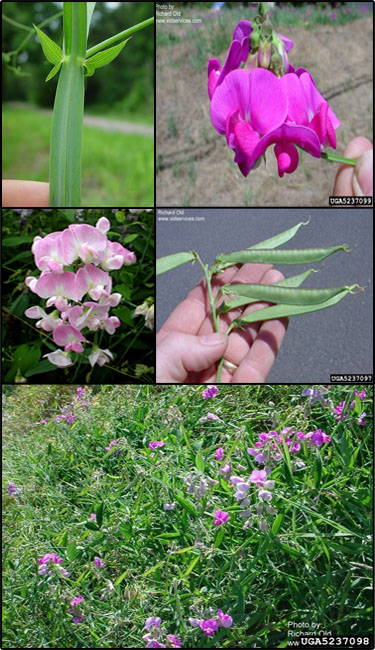Perennial pea (Lathyrus latifolius)
 Synonyms: Lathyrus latifolius L. var. splendens
Synonyms: Lathyrus latifolius L. var. splendensCommon Names: Everlasting peavine, perennial peavine
Description: Popular garden plant but very difficult to remove. Seeds are toxic.
Habit: Trailing or climbing, perennial; up to 6 ft long forb; numerous tendrils, from rhizomes.
Leaves: Alternate, pinnate with 2 leaflets on broadly-winged stalks, oval to lance-shaped, symmetrical leaf-like appendages at the base.
Stems: Erect; broadly winged; 6 ft tall; herbaceous; climbing; glabrous; typically glaucous.
Flowers: White to purplish-red in color, 5-parted, 1/2-1 in long, inflorescence a long-stalked cluster (raceme) of 4-10 stalked flowers.
Fruit and seeds: Long, narrow, smooth pod with 10-15 black/brown seeds.
Habitat: Native to Europe. Found along roadsides, railroads, fencerows, open fields, sometimes cultivated.
Reproduction: Vegetatively or by reseeding itself.
Similar species: Sweet pea (Lathyrus odoratus) and Caley pea (Lathyrus hirsutus).
Monitoring and rapid response: Hand-pull young vines; cut, making sure to remove all fragments and runners; dig out root system. Credits: The information provided in this factsheet was gathered from Missouriplants.com, the Robert W. Freckmann Herbarium and the USDA PLANTS Database.
Individual species images that appear with a number in a black box are courtesy of the Bugwood.org network (http://www.invasive.org).Individual photo author credits may not be included due to the small display size of the images and subsequent difficulty of reading the provided text. All other images appear courtesy of Google (http://images.google.com).
